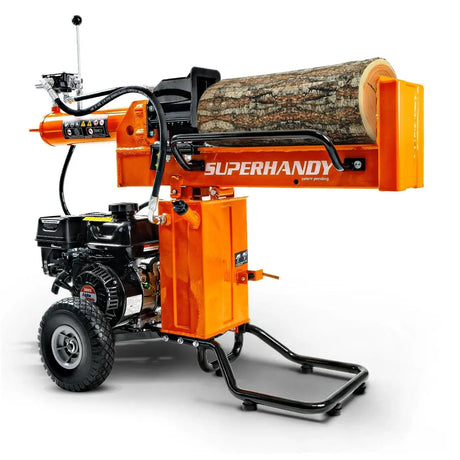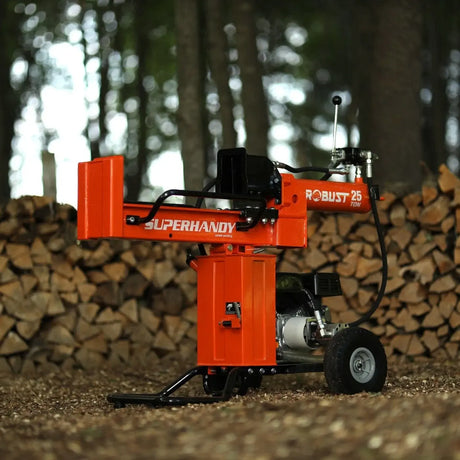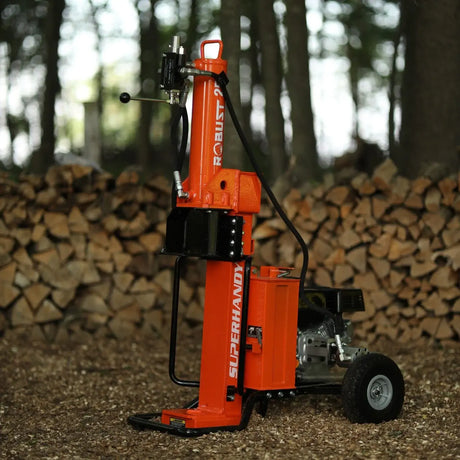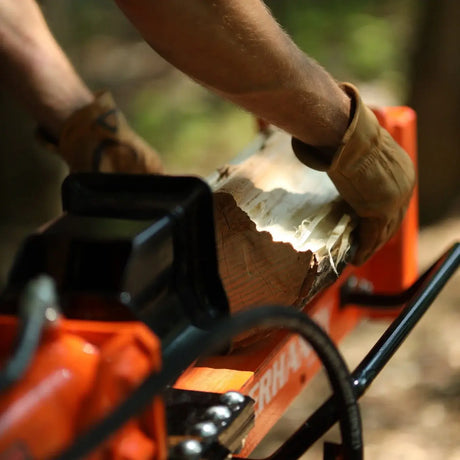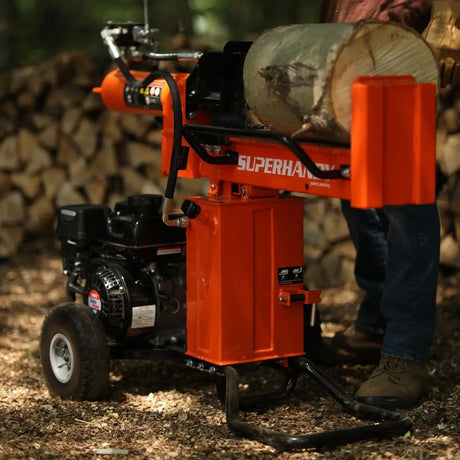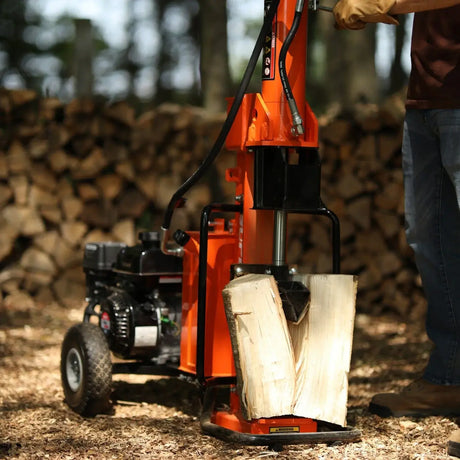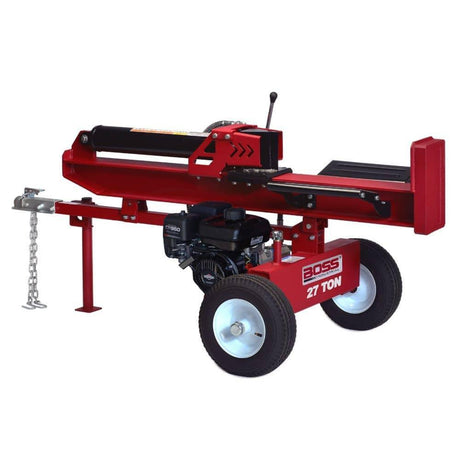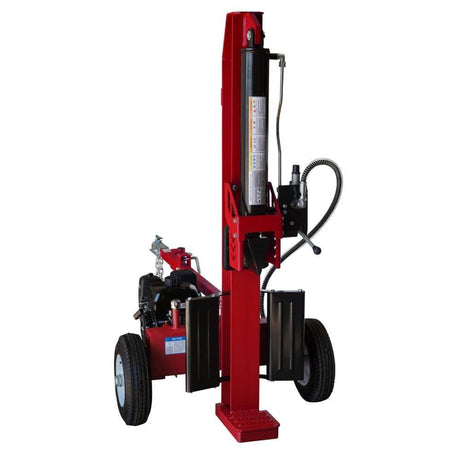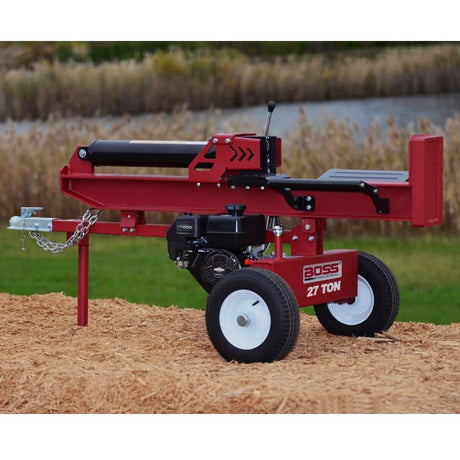SuperHandy
SuperHandy 25 Ton Gas Log Splitter - 7HP 209CC, 20" Max Log Length
$2,088.90Unit price /UnavailableBoss Industrial
Boss Industrial WD37T 37 Ton Horizontal/ Vertical Gas Log Splitter
$2,359.00Unit price /UnavailableBoss Industrial
Boss Industrial WD27T 27 Ton Horizontal/ Vertical Gas Log Splitter
$1,599.00Unit price /Unavailable
Shop Heavy-Duty Commercial Log Splitters for Professional Wood Processing
What Makes a Log Splitter Commercial-Grade?
A commercial log splitter is built to work harder, longer, and under tougher conditions than anything you'd use at home. It's not just about power—it’s about efficiency, durability, and reliability.
What defines a commercial-grade log splitter:
- High tonnage (usually 25 to 35 tons or more) for splitting large, knotted hardwoods
- Reinforced steel frames and beams for structural strength under repeated use
- Gas-powered hydraulic systems with powerful engines (196cc to 420cc)
- Fast cycle times and auto return valves to maximize output
- Designed for daily, high-volume wood splitting
If you're running a firewood business or processing wood all season long, you need a machine that won't quit. These are true industrial log splitters—built for performance and endurance.
Who Should Use a Commercial Log Splitter?
A commercial wood splitter is the right tool for:
- Firewood sellers splitting several cords per week
- Tree service companies handling dense or oversized logs
- Landowners managing large rural properties
- Anyone tired of burning out residential units
If your log pile looks more like a wall and your splitter runs more days than it rests, a pro-grade log splitter is not just a nice upgrade—it’s a necessity.
When a Commercial Splitter Is Worth the Investment
Here's when it makes financial (and physical) sense to upgrade:
- You split over 10 cords per year
- You regularly handle oak, hickory, elm, or frozen logs
- You want a firewood processor alternative without the full automation price tag
- You need reliable performance in all weather
- You're tired of maintenance issues with residential models
A quality commercial firewood splitter pays for itself fast—especially if you're using it for business or large-scale heating needs.
Explore Our Best-Selling Commercial Log Splitters
High-Tonnage Models for Tough, Dense, or Large Logs
The heart of a commercial log splitter is its power. We stock machines that range from 25-ton to 35-ton capacity, specifically designed for:
- Oversized hardwood rounds
- Frozen, knotted, or irregular logs
- Daily high-output jobs
If you're wondering what size logs a 30-ton splitter can handle—the answer is: just about anything you'll throw at it.
Gas-Powered vs. Hydraulic Commercial Log Splitters
Nearly all commercial-grade splitters are gas-powered—and for good reason:
- More horsepower = more splitting force
- Ideal for remote locations with no power access
- Fast cycle speeds that keep production moving
- Engines range from 196cc to 420cc, depending on the model
Most use hydraulic power with a 2-stage gear pump, giving you both speed and force when you need it. It's a true heavy-duty log splitter setup—built for business.
Towable, Horizontal/Vertical, and Dual-Position Options
Commercial splitters aren't just powerful—they're versatile.
- Towable log splitters with 2" hitch and DOT-approved tires
- Dual-position (horizontal/vertical) units for log size flexibility
- Horizontal-only machines with fast cycles for production lines
Whether you're working in the field or splitting in a fixed location, there's a commercial splitter with mobility and positioning that fits your workflow.
Cycle Time, Wedge Types, and Steel Frame Durability
Here's what separates the pros from the rest:
- Cycle time: Under 14 seconds is standard for high-output jobs
- Auto return valve: Keeps hands free and speeds up each split
- Steel wedge types: Choose 2-way or 4-way depending on your log size and volume
- Heavy-duty steel frame and reinforced beam: Built to handle abuse and stay aligned under pressure
- Log cradle or catcher: Prevents downtime and keeps rounds in place
When you're splitting daily, every detail matters. These machines are built to go the distance, cut after cut, cord after cord.
Choosing the Right Commercial Log Splitter for Your Operation
Tonnage and Log Size Considerations for Pro Use
If you're running a firewood business or managing large-scale wood processing, tonnage isn't just a spec—it’s the foundation of your workflow. For commercial use, stick to machines with 25 to 35+ tons of splitting force.
Here's how to size your splitter to the job:
- 25-27 ton: Handles large, seasoned hardwoods up to 24" diameter
- 30-35 ton: Built for green oak, hickory, elm, or knotty frozen rounds
- Higher tonnage = less strain per log = longer machine life
You're not splitting a few logs for the fireplace—you're working through cords of wood every week. The right high-capacity log splitter keeps you efficient and profitable.
Trailer Compatibility and On-Site Mobility
Most commercial splitters are towable, but not all are highway-ready. If you're moving from jobsite to jobsite, pay attention to transport specs:
- 2" coupler hitch: Standard for towing with pickup trucks or UTVs
- DOT-approved tires and lights: Required for road towing
- Sturdy axle and fenders: Hold up under rough terrain
- Vertical/horizontal pivoting: Allows on-site setup with minimal lifting
If you're running a tree service company or delivering splitting services, mobility matters as much as power. Look for a commercial wood splitter that's built to move and survive it.
Safety, Maintenance, and Long-Hour Performance
Pro-level splitting means long hours and non-stop workdays—so safety and maintenance need to be part of your decision.
- Auto return valve: Speeds up cycles and keeps hands away from the wedge
- Log cradle or catcher: Prevents drop-offs and improves workflow
- Reinforced steel beam and welded frame: Keeps the machine aligned under stress
- Easy-access hydraulic tank: For fast fluid checks and top-ups
- Commercial splitter with safety features like guarded levers or shut-off switches
The best log splitters for professional use are designed to run long, stay cool, and stay safe—hour after hour, season after season.
Residential vs. Commercial Log Splitters: Key Differences
Performance, Power, and Durability Comparison
Here's how residential vs. commercial log splitters stack up when it comes to real-world use:
| Feature | Residential Splitter | Commercial Splitter |
|---|---|---|
| Tonnage | 5–20 tons | 25–35+ tons |
| Engine Power | Light-duty (electric or small gas) | Heavy-duty gas (196cc to 420cc) |
| Frame & Beam Strength | Standard welds, lighter steel | Reinforced steel beam & heavy-duty frame |
| Use Frequency | Occasional | Daily, continuous operation |
| Cycle Speed | Moderate | Fast cycle time with auto return |
| Log Size Capacity | Small to medium | Large, dense, knotted logs |
| Portability | Hand-pulled, non-towable | Towable with DOT approval |
If you're producing firewood for your family, residential is fine. But for volume, reliability, and rugged performance, commercial-grade log splitters are in a league of their own.
Which One Fits Your Workflow and Output Needs?
It really comes down to how much wood you're splitting—and how often.
Go commercial if you:
- Split wood daily or multiple times per week
- Sell firewood or supply wood for multiple properties
- Need to process hardwoods, large logs, or frozen timber
- Want a professional log splitter that can run all day without overheating
- Require towable mobility for jobsite work
Stick with residential if you:
- Only split a few cords per year
- Use a woodstove or fireplace at home
- Prefer an electric model for quiet, indoor-friendly use
- Need a compact, easy-to-store unit
Choosing the right tool isn't about specs—it's about matching power and design to your actual workflow. For many pros, the best log splitter for a firewood business isn't optional—it's critical infrastructure.
Frequently Asked Questions (FAQs)
What Tonnage Do I Need for Commercial Splitting?
What Tonnage Do I Need for Commercial Splitting?
For true commercial-grade splitting, you'll want at least 25 tons of force, but most pros prefer machines in the 30-35 ton range—especially if you're dealing with:
- Hardwoods like oak, hickory, elm, or maple
- Large rounds over 20 inches in diameter
- Wet or knotted logs that resist clean splitting
The higher the tonnage, the less effort the machine exerts per cycle—and the less stress on the hydraulic system. If you're building a firewood business or splitting daily, don't settle for less than 27-30 tons. These are heavy-duty log splitters made to power through high volumes without bogging down.
Can a Commercial Log Splitter Be Towed On the Highway?
Can a Commercial Log Splitter Be Towed On the Highway?
Yes—but only if it's built for it. Not every splitter is road tow capable, so check for these must-have features:
- 2-inch coupler hitch
- DOT-approved tires
- Tail lights and safety chains
- Axle rated for highway speed
Many of our models are towable log splitters with full highway compliance, so you can haul them from one jobsite to the next without a trailer. Just make sure your vehicle matches the weight requirements, especially for commercial firewood splitters with larger frames and engines.
How Long Can a Commercial Splitter Run Without Overheating?
How Long Can a Commercial Splitter Run Without Overheating?
A properly designed commercial splitter can run for hours without overheating—as long as the hydraulic system is maintained and airflow around the engine is clear.
- Auto return valve for faster cycles and less load
- Air-cooled engines (196cc, 212cc, 420cc) designed for sustained use
- High-capacity hydraulic tanks that reduce heat buildup
- Regular checks of fluid levels and filters
For firewood sellers or service pros, this is why commercial-grade matters. A residential splitter might stall after an hour. A commercial log splitter for daily heavy-duty use is built to last all day—cord after cord.

